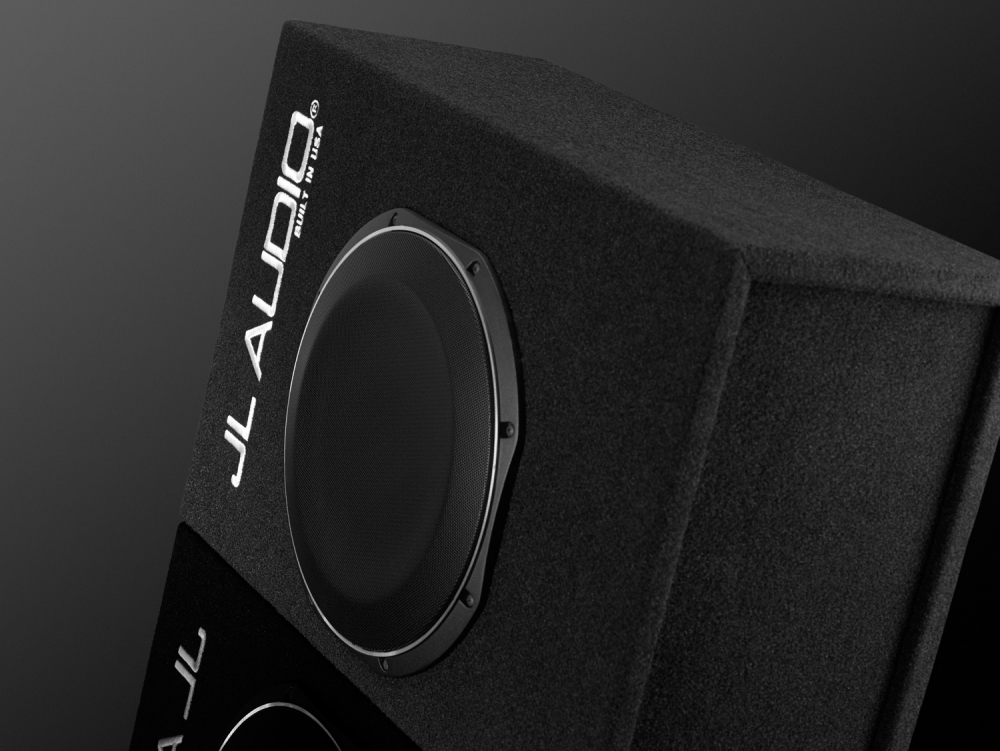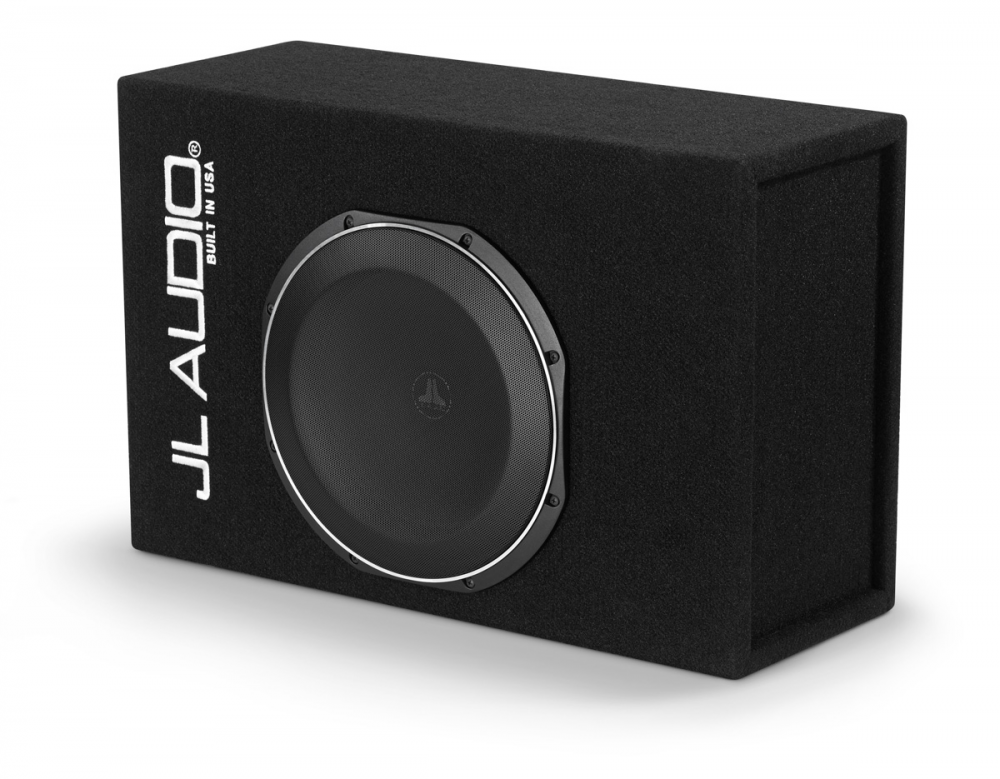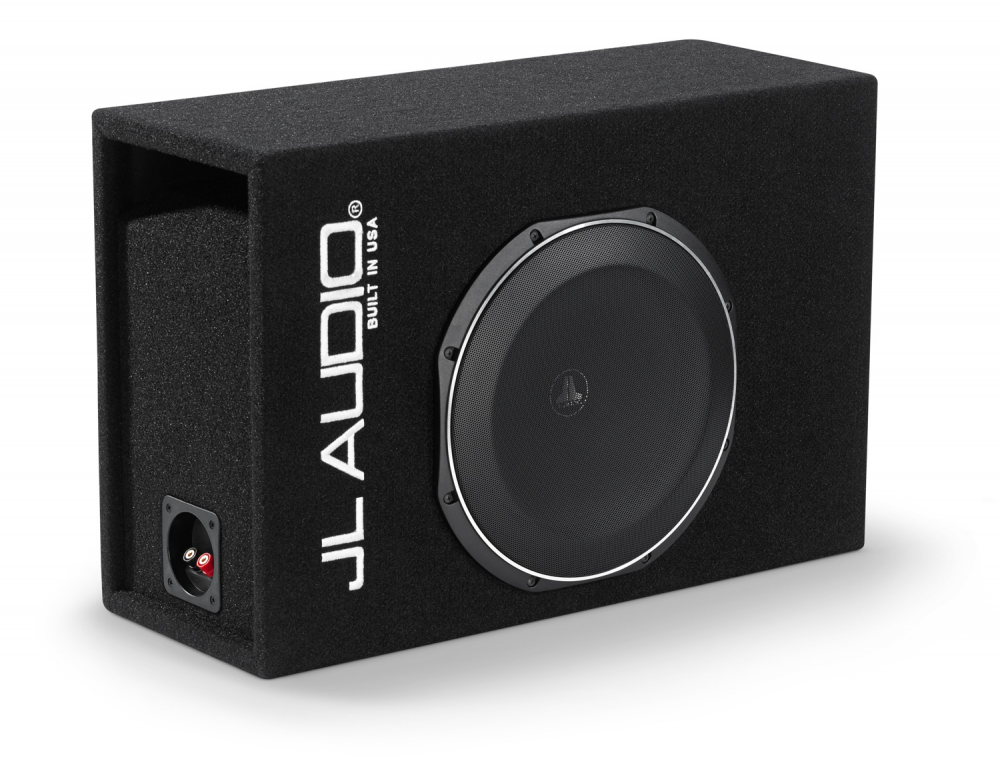


Корпусной сабвуфер с одним НЧ-динамиком 12TW1-2, 300 Вт, 2 Ом
SKU 93326 | Model CP112LG-TW1-2
купить в магазине






Корпусной сабвуфер с одним НЧ-динамиком 12TW1-2, 300 Вт, 2 Ом, корпус с фазоинвертором, покрытие – черный карпет
Даже самые компактные среди корпусных сабвуферов MicroSub™ демонстрируют впечатляющие глубину и мощность глубокого баса, а с переходом к моделям с полноразмерными НЧ-динамиками эти достоинства переходят на новый, потрясающий уровень! В этом сабвуфере применяется наиболее крупный 300-мм (12") НЧ-динамик малой монтажной глубины серии TW1, известной лидирующими звуковыми характеристиками в своем классе. Корпус с щелевым фазоинвертором тщательно оптимизирован для наилучшего раскрытия потенциала динамика. Глубина прямоугольного корпуса составляет 235 мм, что сильно упрощает выбор места расположения сабвуфера. Порт фазоинвертора расположен на одной из боковин, его расширяющийся наружу профиль исключает образование посторонних призвуков. На этой же боковине находится панель коммутации с высококачественными разъемами, допускающими подключение как зачищенного конца кабеля, так и снабженного различными типами коннекторов.
Технология изготовления корпуса V-Groove включает высокоточную обработку элементов конструкции из панелей MDF на станках с ЧПУ, а также особый способ их скрепления друг с другом: внутренние элементы канала фазоинвертора и дополнительные распорки создают эффективную силовую структуру для выдающейся жесткости и герметичности. Снаружи корпус покрыт высококачественным черным карпетом с нарядным вышитым логотипом "JL Audio Made in USA" на фронтальной панели. Надежная металлическая защитная сетка включена в комплектацию.

- Допустимая продолжительная мощность (RMS)
- 300 W
- Номинальное сопротивление динамика
- 2 Ω
- Тип корпуса
- Slot-ported, Low-profile
- Внешний вид
- Black carpet
- Защитный гриль в комплекте
- Black Steel Mesh
- Ширина корпуса (внешняя, W)
- 23.75 in / 603 mm
- Высота корпуса (внешняя, H)
- 15.751 in / 400 mm

- Внешняя глубина (D1)
- 9.25 in / 235 mm
- Вес
- 38.3 lb / 17.37 kg
V-Groove MDF Construction

V-Groove MDF Construction
Summary:
This advanced cabinet-building technique uses CNC-machining to create precise panel joints that make enclosure assembly more efficient and exact.
Detailed Information:
We begin with quality medium-density fiberboard, which is then machined on our CNC-controlled KOMO woodworking stations. These powerful machines are able to cut a wide range of features onto a sheet of MDF, with minimal waste and absolute precision. The KOMO machines cut out the woofer holes, terminal holes, cut dado grooves, create countersinks and most importantly, cut the angles at the edges of the panels that form the enclosure's main shell so that these panels fit together precisely, with no gaps or leaks.
Once the panels are cut, assembly technicians line them up in the correct order and glue their outer faces onto a long piece of carpet, creating a "wrap": a long series of panels, hinged temporarily by the carpet. In the next assembly step, our wood assembly teams fill the V-grooves between the panels and any dado grooves that receive dividers or secondary wraps with wood-glue. Once the glue is applied, the enclosure shells folds together along the V-grooves, capturing dividers in the dado grooves and secondary wraps, and evenly spreading the glue throughout the joints. One line of mechanical fasteners is applied to hold the structure together while the wood glue dries.
The V-groove technique greatly improves assembly efficiency, and also results in a far stronger and better sealed enclosure than the typical butt-joint construction found on imported enclosures. The quality of the MDF used in JL Audio systems is also vastly better than the typical "China-Grade MDF" used in the imported products.
Flared Slot-Port

Flared Slot-Port
Summary:
The flared slot-port design reduces turbulence at the port mouth so as to minimize any audible airflow effects common to ported enclosures.
Detailed Information:
While ported enclosures deliver important efficiency advantages over their sealed counterparts, they also present unique design challenges. In car audio, the desire for lower tuning frequencies from small enclosure volumes leads to long port lengths that often require compromising the port area. These compromises lead to higher airflow speeds through the port, which can create noise as the air is driven across the the edge of the port. The flared port design minimizes these airflow effects by providing a smooth transition for the high-speed air flow, rather than an abrupt termination. The result is less noise and cleaner-sounding bass.
Dynamic Motor Analysis (DMA) – динамический анализ для оптимизации магнитной системы громкоговорителя

Dynamic Motor Analysis (DMA) – динамический анализ для оптимизации магнитной системы громкоговорителя
Суть вопроса:
Система Dynamic Motor Analysis (DMA) представляет собой мощное программное обеспечение, моделирующее электромагнитные процессы по методу конечных элементов (Finite Element Analysis – FEA) разработанное и впервые представленное JL Audio в 1997, чтобы научно решить проблему линейности динамиков. Использование усовершенствованной с годами системы DMA при проектировании динамиков позволяет значительно снизить искажения и улучшить переходные характеристики… или, проще говоря, получить плотный, неискажённый артикулированный бас.
Подробная информация:
Начиная с 1997 года JL Audio является лидирующей компанией, разрабатывающей элементы подвеса и магнитной системы динамиков с использованием моделирования по методу конечных элементов. Целью этих исследований является расшифровка “геномома громкоговорителя”, понимание и оценка его реального поведения в движении при подаче на динамик реального сигнала определённой мощности. Основным компонентом этой интегрированной системы моделирования является DMA (Dynamic Motor Analysis). Начиная с модели 15W3 и сабвуферов серии W7 в конце 1990-х и начале 2000 х годов, анализ DMA сыграл важную роль в формировании дизайна всех громкоговорителей JL Audio, включая наши компонентные акустические системы.
DMA – это система анализа на основе метода конечных элементов (Finite Element Analysis – FEA), это означает, что она берёт большую комплексную задачу, разбивает ее на небольшие элементы для анализа, а затем собирает данные для формирования “общей картины” точного решения. Технологический прорыв DMA заключается в том, что он фактически учитывает взаимное влияние подводимого к катушке мощного сигнала и положение катушки/диффузора динамика в рамках анализа во временной области. Это дает нам очень точную модель фактического поведения динамика при подаче на него сигнала с реальной мощностью, чего не могут сделать традиционный метод Тиля-Смолла или другие измерения параметров на низкой мощности. Поскольку DMA анализирует не стационарную модель, можно изменять параметры схемы в поисках оптимальных параметров. Процесс моделирования происходит в течение длительного периода времени для каждого динамика.
DMA способен анализировать реальные эффекты колебания мощности и при перемещении катушки относительно магнитной системы динамика, в частности динамические изменения “фиксированного” магнитного поля. Это дает чрезвычайно ценную информацию по сравнению с традиционным моделированием, которое для простоты расчета предполагает, что так называемое “фиксированное” магнитное поле, создаваемое в зазоре звуковой катушки неизменно. DMA не только показывает, что это “фиксированное” поле на самом деле изменяется из-за влияния магнитного поля, создаваемого током, протекающим через звуковую катушку, но и помогает нашим инженерам найти решения, которые минимизируют эту нестабильность. Анализ этого поведения имеет решающее значение для понимания механизмов возникновения нелинейных искажений в моторе динамика и проливает свет на аспекты конструкции магнитной системы, которые определяют его линейность:
- Линейность силы магнитной системы в рабочем диапазоне перемещения подвижной системы громкоговорителя
- Постоянство силы магнитной системы с обоими величинами тока проходящего через звуковую катушку – положительной и отрицательной
- Постоянство сила магнитной системы при различных уровнях мощности подводимого сигнала
Применение системы DMA позволяет нашим инженерам электроакустикам вносить критические изменения в конструкцию и создавать динамики с линейными и высокостабильными магнитными системами.
Любой динамик произведенный компанией JL Audio обладает пониженным уровнем искажений, улучшенными переходными характеристиками и превосходным качеством звучания.
Engineered Lead-Wire System (U.S. Patent #7,356,157)

Engineered Lead-Wire System (U.S. Patent #7,356,157)
Summary:
Carefully engineered lead-wire design and attachments ensure controlled, quiet lead-wire behavior under the most extreme excursion demands.
Detailed Information:
Managing the lead-wires on a long-excursion woofer is one of the trickier aspects of its mechanical design. To address this, many long-excursion woofers today rely on a simple solution that weaves the lead-wires into the spider (rear suspension) of the driver.
The biggest problem with this approach is that spider limiting behavior plays a hugely important role a woofer's performance. Lead-wires that are attached or woven into the spider material can alter the spider's "stretching" behavior. The tinsel wire naturally has less 'give' than the fabric material of the spider leading to asymmetrical spider behavior and non-uniform stress distribution around the spider circumference. The wire attachment points can also cause localized pulling and tearing forces at the spider's excursion limits. As such, longevity becomes a major concern and makes the woven-in design less than ideal for very long-excursion designs.
While a traditional 'flying lead' design does not compromise spider linearity or radial stability, it creates its own challenges on a long-excursion woofer. Managing the 'whipping' behavior of the wire and making sure it does not contact the cone or spider is one challenge. Another is ensuring that the leads do not short one another or the frame of the woofer.
To overcome these issues, JL Audio's engineered flying lead-wires work in conjunction with carefully engineered entry and exit support structures molded into the terminals and the voice coil collar. Some models also feature jacketed lead-wires to further reduce the likelihood of shorting and fatigue. The result is flawless high-excursion lead-wire behavior, with outstanding reliability and none of the compromises inherent to a woven-in lead wire system. Building woofers this way requires much more labor and parts complexity than the simpler woven-in approach, but the payoff is in reduced distortion, reduced mechanical noise and improved reliability.
Tab-Ear Frame Design

Tab-Ear Frame Design
Summary:
This frame design feature facilitates mounting the subwoofer driver in tight spaces.
Detailed Information:
By employing a tab-ear mounting system, the driver's overall outside dimensions are reduced, permitting it to be mounted in a space that is very similar to that required by the next smaller round woofer frame.
In this example, the “Tab-Ear” frame design allows a 13TW5 13.5-inch driver to fit in a space only slightly larger than a conventional 12-inch woofer requires (only 0.44 in. / 11.2 mm bigger)

Concentric Tube Suspension (U.S. Patent #5,734,132 & #6,095,280)

Concentric Tube Suspension (U.S. Patent #5,734,132 & #6,095,280)
Summary:
Our patented Concentric Tube Suspension™ technology delivers unprecedented excursion in a low-profile woofer.
Detailed Information:
The biggest challenge in any low-profile woofer design is to create enough mechanical clearance for the speaker to generate enough excursion to meet its output and low-frequency extension goals. Since these goals were very ambitious in the development of JL Audio's low profile woofers, achieving them required development of a new suspension architecture.
JL Audio's patented solution employs a molded structure which spans over the edge of the motor system, supporting the spider on the outside of the motor's boundaries and the large diameter voice coil on the inside. The large diameter voice coil permits the magnet to sit inside it, rather than surrounding the coil as is typical in most woofers.

The concentric tube structure and the elimination of a conventional top-plate helps us place the motor system higher up into the cone body's space to further compress depth, while still permitting excellent mechanical excursion.
Precision Built in U.S.A.

Precision Built in U.S.A.
Summary:
JL Audio's Miramar, Florida loudspeaker production facility is one of the most advanced in the world.
Detailed Information:
At a time when most audio products are built overseas, JL Audio’s commitment to in-house loudspeaker production continues to grow. All W7’s, W6’s, TW5’s, TW3's, TW1's, W3v3’s and some of our ZR products. We also build our Marine Speaker Systems, Home Subwoofers, Stealthbox® products and the vast majority of our enclosed subwoofer systems in Florida.
To pull this off in a competitive world market, our production engineering team has created one of the world’s most advanced loudspeaker assembly facilities. This commitment to state-of-the-art technology allows our highly skilled workforce to efficiently build JL Audio products to extremely high quality standards.
While it is also feasible to build good quality products overseas (and we do build some of our products in Europe and Asia), it can be challenging when the product’s technology is innovative or complex. Since most of our premium loudspeakers incorporate proprietary, patented technologies requiring specific assembly techniques, we prefer that the people who design them have close access to the people manufacturing them.